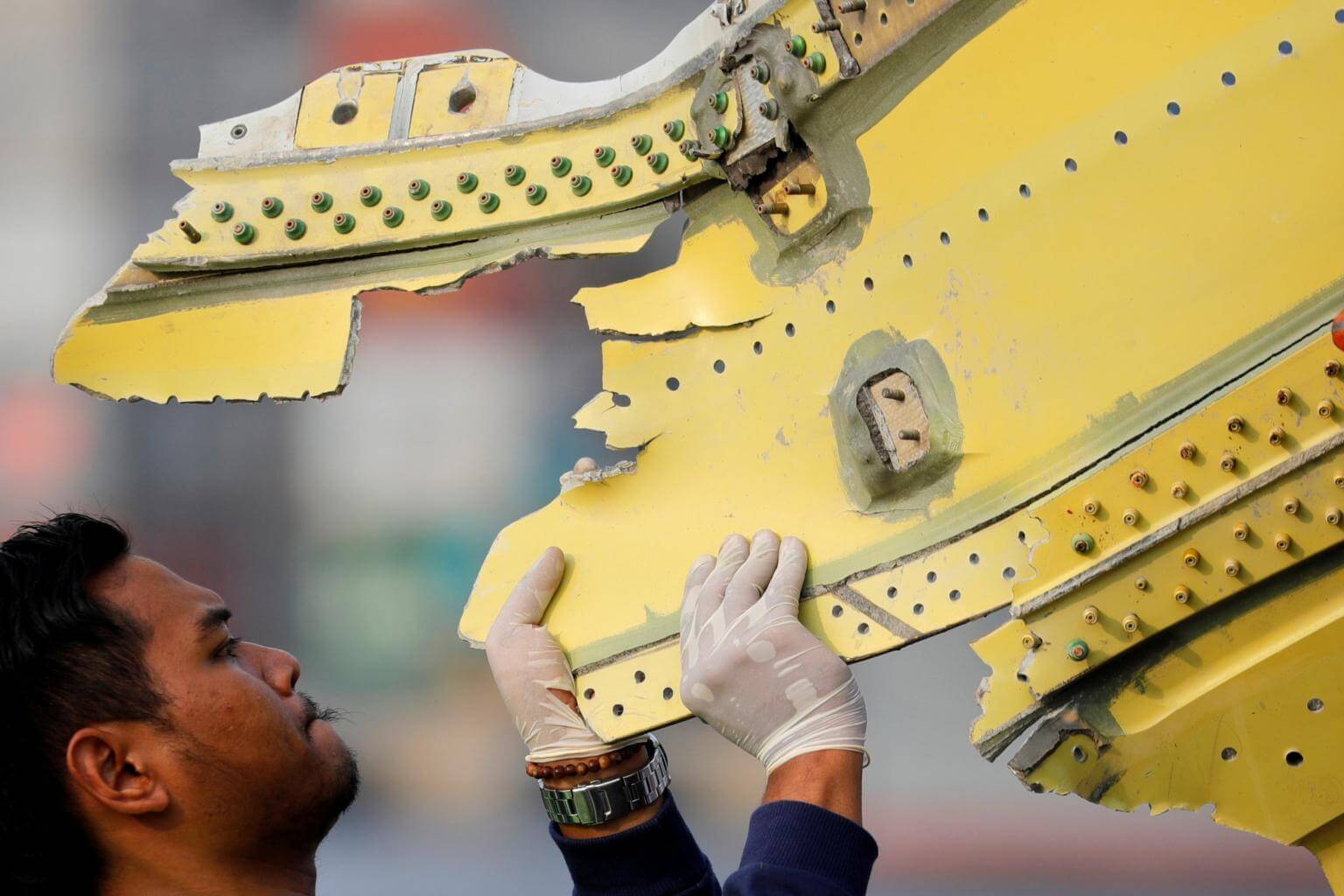Lion Air crash: Even the strongest body part of plane broke apart, says Indonesian official
Sign up now: Get insights on Asia's fast-moving developments

Some experts have said the Boeing 737 Max 8 plane nosed downward so abruptly that it may have hit speeds of 1,000kmh or more before slamming into the sea.
PHOTO: REUTERS
Follow topic:
JAKARTA - Indonesia's National Transportation Safety Committee (KNKT) said on Monday (Nov 5) that the Lion Air jetliner that plunged into the Java Sea last Monday suffered a more devastating crash impact than an AirAsia flight that crashed into the sea in December 2014.
All 189 passengers on board Lion Air Flight JT610 are feared dead after the plane crashed 13 minutes after take-off from Jakarta. The plane was bound for Pangkal Pinang.
It was Indonesia's worst aviation disaster since a Garuda Indonesia plane crashed in Medan in 1997, killing all 214 people on board.
The size of the debris collected so far showed the ill-fated Lion Air dived into the water at high speed and the plane broke in pieces upon impact with the water body, Mr Soerjanto Tjahjono, chief of the National Transportation Safety Committee, told a radio station.
His comments effectively ruled out earlier suggestions by some quarters that the plane might have broken apart in mid-air.
"The plane broke apart upon impact when it hit the water. There has been no signs of material fatigue. There were worries by some that the plane broke apart in mid-air due to material fatigue. We can confirm it is not the case," he told Elshinta radio.
"The Lion Air crash is more devastating than Air Asia's. Lion Air fell hard into the sea at high speed, while the Air Asia (plane) stalled and glided into the sea," he said, referring to AirAsia Flight QZ8501 which crashed into the Java Sea off Borneo 40 minutes after take-off from Surabaya. There were 162 people on board the Singapore-bound flight.
"At impact, in the Lion Air case, the engine was running at high speed."
Some experts have said that the Boeing 737 Max 8 plane nosed downward so abruptly that it may have hit speeds of 1,000kmh or more before slamming into the sea.
The search team have recovered a flight data recorder, both the engines, a part of the landing gear, body parts of victims and personal belongings in a week-long search which was extended for three more days on Sunday.
In comments that highlighted the challenges ahead as divers continued on Monday to search for the main wreckage and cockpit voice recorder, Mr Soerjanto said the chances of finding the Lion Air plane's fuselage in one good piece are not high as even its strongest body part was torn apart in the crash.
The KNKT chief said last week that a preliminary report of the investigations into one of the country's worst aviation disasters will be released in about a month while a complete study may take up to six months.
KNKT chief Mr Soerjanto said on Monday his agency has managed to download data from flight data recorder, consisting data of past 19 flights.
He told reporters that search teams have not been able to detect any signal from the missing cockpit video recorder (CVR) since two days ago, but he stressed that the authorities will do their utmost to retrieve the device which experts say is crucial to unraveling what happened during the Lion Air plane's final moments on Oct 29.
Referring to the CVR, a senior official at the national search and rescue agency (Basarnas) told The Straits Times:"It's buried under the sea mud. When strong sea current comes, it will unearth the device or at least reduce the thickness of the mud covering it, allowing the signal to be picked up again."
He added that search teams had earlier detected signals from both equipment - flight data recorder and cockpit video recorder - at the onset of the search operations. The CVR had weaker 'ping' signals even at that time because it was covered by mud, said the Basarnas official who spoke on condition of annonymity.
In particular, the device, also known as audio black box, may explain why the crew of JT610 asked to return to base minutes into the journey, and reveal any exchanges in the cockpit before the fatal high-speed plunge into the sea, reported Bloomberg News.
So far 138 body bags containing human remains have been recovered. Fourteen victims have been identified by DNA tests and their personal belongings.
"Today, we will do an identification process on more than 30 body bags. Methods used are fingerprints, matching dental records, DNA, as well as matching personal belongings," Colonel Lisda Cancer, head of Indonesian national police DVI (Disaster Victim Identification) department, told Elshinta radio.
The Indonesian Transport Ministry said in a statement that the authorities are also conducting a "special audit" of the standard operating procedures of the budget airline, the flight crew's qualifications and coordination with industry stakeholders.
The government had already ordered a review of Lion Air's repair and maintenance unit and suspended several managers as it emerged the ill-fated jet had reported some technical issues on a flight from Bali to Jakarta a day before the crash.

